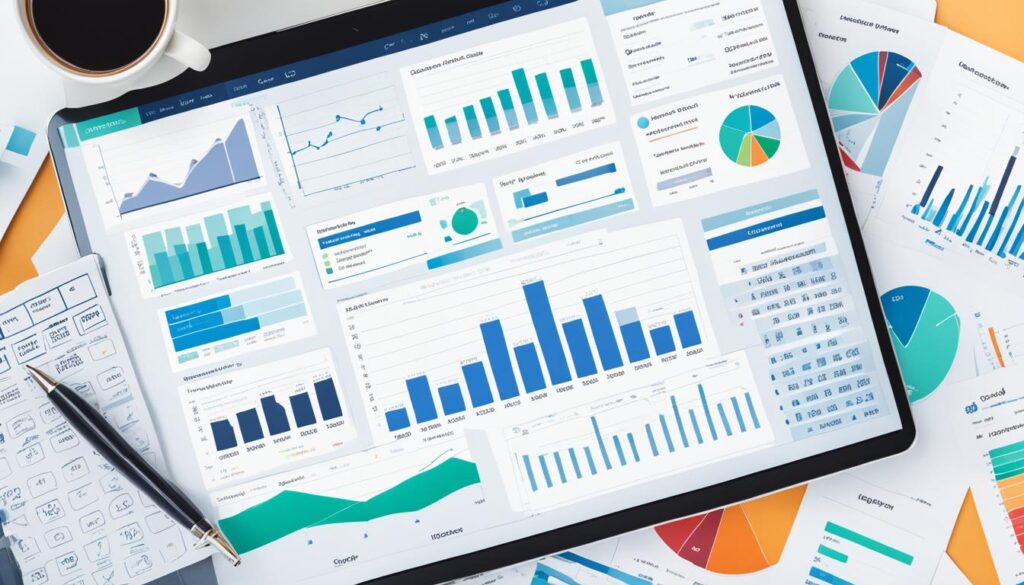Cash flow management is crucial for the financial health of small and medium-sized businesses (SMBs). By effectively tracking and controlling the cash that flows in and out of their accounts, SMBs can ensure they have enough working capital, reduce excess cash, and make more profitable business decisions. Cash flow management tools, such as cash flow analysis software and financial management apps, can streamline the budgeting, forecasting, and reporting processes, providing SMBs with real-time insights into their cash flow.
Key Takeaways:
- Cash flow management tools are essential for SMBs to track and control their cash flow effectively.
- These tools streamline the budgeting, forecasting, and reporting processes, providing real-time insights into cash flow.
- By optimizing cash flow, SMBs can ensure they have enough working capital and make more profitable business decisions.
- Cash flow analysis software and financial management apps are popular tools used by SMBs for effective cash flow management.
- Choosing the right cash flow management tool is crucial for optimizing cash flow and improving the financial health of SMBs.
What is Cash Flow Management?
Cash flow management involves tracking and controlling the cash that enters and leaves a business’s accounts. Its main goals are to maintain healthy levels of working capital and liquidity and provide a foundation for growth and expansion.
Cash flow management plays a crucial role in ensuring that businesses have enough working capital to cover their operating expenses, such as payroll, rent, and inventory. By monitoring cash inflows and outflows, businesses can better understand their financial position and make informed decisions.
Tasks involved in cash flow management include calculating expenses, reducing excess cash, building cash reserves, tracking spending, and optimizing the use of cash. Effective cash flow management allows businesses to allocate resources strategically, invest in growth opportunities, and mitigate the risk of financial instability.
“Effective cash flow management is the lifeblood of a business. It provides the necessary liquidity to meet financial obligations and seize growth opportunities.”
| Benefits of Cash Flow Management | |
|---|---|
| 1. | Ensures a healthy level of working capital. |
| 2. | Provides a foundation for growth and expansion. |
| 3. | Helps in making informed financial decisions. |
| 4. | Reduces the risk of financial instability. |
| 5. | Optimizes the use of cash resources. |
| 6. | Minimizes the reliance on external financing. |
Cash flow management is especially important for FP&A (Financial Planning and Analysis) teams who are responsible for monitoring and analyzing the company’s cash flow. By accurately forecasting cash flow, these teams can make strategic decisions to ensure the company’s financial stability and future growth.
Why is Cash Management Important?
Cash management plays a crucial role in the financial success of businesses. By effectively managing cash flow, businesses can ensure they always have enough funds to cover their expenses. These expenses may include payroll, debt repayments, bank fees, rent, utilities, and insurance. When a business is unable to meet its financial obligations, it risks insolvency, which can have severe consequences for its operations and reputation.
With proper cash management, businesses can avoid financial troubles and maintain a healthy financial position. By tracking and controlling the inflow and outflow of cash, businesses can make informed decisions about their spending and investments, ensuring they allocate their resources wisely.
Having a sustainable cash management strategy in place enables businesses to:
- Anticipate and plan for future expenses
- Minimize the risk of financial emergencies
- Improve cash flow forecasting
- Optimize working capital
- Enhance liquidity
By prioritizing cash management, businesses can proactively address financial challenges, maintain stability, and position themselves for growth and success.
“Cash management is the heartbeat of a business. It determines the organization’s ability to meet its financial obligations and make strategic decisions.”
Businesses that neglect cash management may find themselves facing cash shortages, unable to pay bills or suppliers, and hampered in their ability to seize growth opportunities. On the other hand, those that prioritize cash management can not only sustain their operations but also optimize their financial resources, drive profitability, and stay ahead of the competition.
The Benefits of Effective Cash Management
How to Do Cash Management with Multi-Currency Accounts?
Managing cash in multi-currency accounts can be complex, especially with fluctuating exchange rates. Businesses dealing with different currencies need a systematic approach to ensure accurate cash flow analysis and effective cash management.
Cash management involves tracking and controlling the cash that enters and leaves a business’s accounts. In the case of multi-currency accounts, businesses need to consider various factors, such as exchange rates, to ensure accurate cash management.
Accounting software plays a crucial role in simplifying cash management tasks. It can convert cash from different currencies into a standardized format, which can then be imported into analysis and reporting tools like Excel. This enables businesses to have a comprehensive view of their cash flow, regardless of the currencies involved.
“By employing cash flow analysis software with multi-currency capabilities, businesses can streamline their cash management processes and make more informed decisions.”
Cash flow analysis software offers a range of benefits for managing cash in multi-currency accounts. It allows businesses to track and manage cash in different currencies, ensuring accurate cash flow analysis and forecasting. With real-time insights into cash flow, businesses can make more informed decisions related to currency exchange and optimize their cash management strategies.
Benefits of Cash Flow Analysis Software for Multi-Currency Accounts
To illustrate the advantages of using cash flow analysis software for managing multi-currency accounts, let’s look at the following table:
| Traditional Approach | Cash Flow Analysis Software | |
|---|---|---|
| Exchange Rate Updates | Manual process, prone to errors | Automatically updated in real-time |
| Cash Flow Analysis | Time-consuming, difficult to consolidate data | Efficient and accurate analysis across multiple currencies |
| Decision-making | Limited insights and analysis | Enhanced insights and informed decision-making |
The table above highlights the key differences between the traditional approach to cash management and the use of cash flow analysis software. With the software, businesses can automate exchange rate updates, ensuring accurate currency conversions. Additionally, the software simplifies cash flow analysis by consolidating data across different currencies, providing efficient and accurate insights.
By employing cash flow analysis software with multi-currency capabilities, businesses can streamline their cash management processes and make more informed decisions. The software ensures accurate cash flow analysis and forecasting, allowing businesses to optimize their cash management strategies and navigate the complexities of managing multi-currency accounts.
Cash Flow Management vs. Cash Flow Forecasting
Cash flow management and cash flow forecasting are two essential components of effective financial planning for businesses. While both aim to ensure the financial stability and growth of the company, they focus on different aspects of cash flow.
Cash flow management primarily deals with the present state of a business’s cash flow. It involves tasks such as tracking expenses, optimizing cash inflows and outflows, and ensuring that the company has enough liquidity to meet its immediate financial obligations. By actively managing cash flow on a day-to-day basis, businesses can maintain a healthy financial position and make informed decisions about their spending and investments.
Cash flow forecasting, on the other hand, revolves around estimating the future cash flow of a company. It involves analyzing historical data, market trends, and business projections to predict the amount and timing of future cash inflows and outflows. FP&A teams and CFOs utilize cash flow forecasting to anticipate potential cash shortfalls or surpluses, make strategic investment decisions, and ensure the business never runs out of cash and faces insolvency.
“Cash flow management focuses on the present, while cash flow forecasting looks towards the future. Both are critical for effective financial planning and decision-making.”
By combining cash flow management and cash flow forecasting, businesses can achieve comprehensive financial control and strategic insights. The FP&A teams play a crucial role in this process, utilizing their expertise and analysis to optimize cash flow, anticipate financial needs, and guide the company towards sustainable growth.
The Role of FP&A Teams in Cash Flow Management and Forecasting
FP&A teams, short for Financial Planning and Analysis teams, are responsible for overseeing the financial health of the organization and providing critical insights for decision-making. They play a crucial role in cash flow management and forecasting by:
- Monitoring and analyzing cash flow patterns to identify trends and anomalies
- Working closely with other departments to gather data and evaluate financial risks
- Creating accurate cash flow forecasts based on historical data and market analysis
- Developing cash flow optimization strategies to mitigate financial risks and maximize liquidity
- Providing recommendations to the management team for effective cash flow management
With their expertise and understanding of financial dynamics, FP&A teams are instrumental in ensuring the company’s cash flow remains optimized and aligned with the organization’s objectives. They bridge the gap between financial data and decision-making, enabling the business to make informed choices that drive sustainable growth.
Key Differences Between Cash Flow Management and Cash Flow Forecasting
| Cash Flow Management | Cash Flow Forecasting |
|---|---|
| Focuses on the present state of cash flow | Estimates future cash flow based on historical data |
| Involves expense tracking and optimization | Requires analysis of historical data and market trends |
| Ensures immediate liquidity and financial stability | Anticipates potential cash shortfalls or surpluses |
| Essential for day-to-day financial decision-making | Guides long-term strategic planning and investment decisions |

In conclusion, cash flow management and cash flow forecasting are interrelated practices that businesses should adopt to optimize their financial health. While cash flow management ensures the present stability of cash flow, cash flow forecasting enables businesses to plan for the future and make informed decisions. Effective collaboration between FP&A teams and other stakeholders is crucial for successful cash flow management and forecasting, enabling businesses to navigate financial challenges and achieve long-term growth.
What is Cash Flow Management Software?
Cash flow management software is a valuable tool that helps businesses effectively manage their cash flows, ensuring financial stability and informed decision-making. By automatically connecting income statement and balance sheet information from their accounting software, this software organizes the data into comprehensive cash flow statements and reports. These reports provide real-time insights into the nuances of cash flow, empowering businesses to make data-driven financial decisions.
The software enables businesses to align their financial statements accurately, analyze the impact of net income on cash flow, and access up-to-date and accurate cash flow data at any time. By streamlining the cash flow management process, this software saves businesses time and effort, allowing them to focus on other critical aspects of their operations.
Cash flow management software plays a crucial role in financial reporting as well. It simplifies the preparation of cash flow statements, ensuring compliance with accounting standards and regulations. This software offers user-friendly interfaces, making it accessible for both accounting professionals and business owners who may not have extensive financial expertise.
As evident in the table, cash flow management software offers diverse features and integrations to cater to the unique needs of businesses. This software empowers companies to gain greater control over their financials and make strategic decisions based on accurate and timely cash flow data.
What is Cash Flow Forecasting Software?
Cash flow forecasting software is a powerful tool that goes beyond cash flow management software by enabling businesses to predict future cash flows. With this software, businesses can forecast their cash flow for the future, allowing them to evaluate different scenarios and make strategic decisions based on accurate predictions.
One of the key features of cash flow forecasting software is its ability to simulate what-if scenarios. This means that businesses can test different assumptions and variables to see how they would impact their future cash flow. For example, they can explore the effects of changes in sales volume, pricing, expenses, or investment decisions.
By utilizing what-if scenarios, businesses can gain insights into the potential outcomes of different strategies and make more informed decisions. They can assess the feasibility and profitability of various initiatives and develop contingency plans to mitigate risks. Cash flow forecasting software empowers businesses to plan for the future with confidence and strategically allocate their resources.
The Benefits of Cash Flow Forecasting Software
Using cash flow forecasting software offers several advantages:
- Accurate Future Predictions: With cash flow forecasting software, businesses can make more accurate predictions about their future cash flow. By considering historical data and incorporating potential changes, the software provides a reliable estimation of cash inflows and outflows.
- Improved Decision-Making: By simulating different what-if scenarios, businesses can make better-informed decisions. They can evaluate the financial implications of different strategies and prioritize initiatives that are most likely to generate positive cash flow.
- Strategic Planning: Cash flow forecasting software helps businesses plan for the future. By understanding their expected cash flow, they can anticipate potential shortfalls or surpluses and take proactive measures to address them. This allows for more effective resource allocation and long-term strategic planning.
- Optimize Funding and Investments: Businesses can use cash flow forecasting software to assess their future cash flow needs. By understanding their funding requirements, they can plan ahead for potential financing or investment opportunities to support their growth.
Overall, cash flow forecasting software complements cash flow management software by providing businesses with valuable insights into their future financial position. It empowers businesses to make strategic decisions, plan for contingencies, and optimize their cash flow for future success.
Why Use Cash Flow Management Software?
Cash flow management software offers several benefits for SMBs, providing them with the tools they need to effectively track and manage their cash flow. By leveraging this software, businesses can make more informed and profitable decisions, stay on top of their bank accounts, save time and money through automation, and gain a better understanding of their financials.
Real-Time Data for Better Decision Making
One of the key benefits of cash flow management software is its ability to provide real-time data about a business’s cash flow. This means that business owners and finance teams can access up-to-date information about their cash inflows and outflows, allowing them to make timely and informed decisions. Whether it’s deciding on investments, managing expenses, or planning for future growth, having access to real-time data empowers businesses to make smarter choices that will drive profitability.
Streamlined Financial Statements
Cash flow management software simplifies the process of aligning the three main financial statements: the income statement, the balance sheet, and the cash flow statement. This alignment provides better visibility into the ending cash balance, enabling businesses to have a comprehensive view of their financial position. By having all the statements in one place, businesses can easily assess their cash flow, identify potential areas of concern, and make adjustments to improve their financial health.
Integration with Excel and Google Sheets
Cash flow management software often allows for seamless integration with popular spreadsheet programs like Excel and Google Sheets. This integration makes it easy for businesses to import data, perform analyses, and generate reports using familiar tools. By leveraging the power of Excel and Google Sheets alongside cash flow management software, businesses can create custom reports, perform complex data analysis, and gain deeper insights into their cash flow management.
Automation for Efficiency
Managing cash flow manually can be time-consuming and prone to errors. Cash flow management software automates many of the tasks involved in tracking and analyzing cash flow, saving businesses valuable time and reducing the chance of human error. By automating processes such as data entry, calculation, and reporting, businesses can streamline their cash flow management and focus on other critical aspects of their operations.
A Clear Picture of Financials
Accurate cash flow management provides businesses with a clear picture of their financial health. With cash flow management software, businesses can track their income, expenses, and cash flow trends over time, gaining a better understanding of their business’s financial stability. This knowledge allows businesses to identify areas for improvement, plan for future cash flow needs, and ensure that they have enough working capital to support their operations and growth.
“Cash flow management software provides SMBs with the necessary tools to gain better insights into their cash flow, make informed decisions, and improve their financial health in a dynamic and ever-changing business landscape.”
Overall, cash flow management software is a valuable asset for SMBs looking to optimize their cash flow, make profitable business decisions, and achieve long-term financial success.
| Benefits of Cash Flow Management Software |
|---|
| Real-time data for informed decision making |
| Streamlined financial statements for better visibility |
| Integration with Excel and Google Sheets |
| Automation for increased efficiency |
| A clear picture of financials for better understanding |
Conclusion
Effective cash flow management is crucial for the financial health and growth of small and medium-sized businesses (SMBs). By utilizing cash flow management tools, such as cash flow analysis software and financial management apps, SMBs can optimize their cash flow and make more informed and profitable business decisions.
These tools provide real-time insights into cash flow, helping SMBs streamline their budgeting and forecasting processes. With accurate and up-to-date information, businesses can align their financial statements and gain a better understanding of their financial health.
In addition, cash flow management tools simplify the management of multi-currency accounts, allowing SMBs to navigate fluctuating exchange rates more efficiently. By centralizing and automating cash flow analysis and reporting, these tools save time and effort for SMBs, enabling them to focus on growing their businesses.
For SMBs looking to improve their financial health and achieve long-term success, implementing cash flow management software is a valuable asset. It optimizes cash flow, ensures real-time data insights, and empowers SMBs to make profitable business decisions. With these tools in place, SMBs can take full control of their cash flow and position themselves for sustainable growth.
Learn More About Amazon Financials
FAQ
What are some cash flow management tools for SMBs?
Some cash flow management tools for SMBs include cash flow analysis software and financial management apps.
What is cash flow management?
Cash flow management involves tracking and controlling the cash that enters and leaves a business’s accounts to maintain healthy levels of working capital and liquidity.
Why is cash management important?
Cash management is important because it ensures that a business always has enough cash to pay its expenses, thereby avoiding financial troubles and making informed decisions about spending and investments.
How can cash management be done with multi-currency accounts?
Cash management with multi-currency accounts can be complex due to fluctuating exchange rates. Accounting software can convert cash from different currencies into a standardized format, allowing for accurate cash flow analysis and forecasting across multiple currencies.
What is the difference between cash flow management and cash flow forecasting?
Cash flow management focuses on the present state of a business’s cash flow, involving tasks like expense tracking and optimization. Cash flow forecasting estimates a company’s future cash flow by analyzing historical data, helping to ensure the business never runs out of cash.
What is cash flow management software?
Cash flow management software automatically connects income statement and balance sheet information from accounting software, organizing it into cash flow statements and reports for real-time insights into cash flow.
What is cash flow forecasting software?
Cash flow forecasting software allows businesses to predict future cash flows across multiple scenarios, helping them to plan for the future and make strategic decisions based on accurate predictions of their cash flow needs.
Why should businesses use cash flow management software?
Cash flow management software offers benefits such as better visibility into ending cash balance, analysis of net income on the cash flow statement, easy integration with Excel and Google Sheets, and real-time data for more profitable decisions and a better understanding of financials.
How can cash flow management tools benefit SMBs?
By utilizing cash flow management tools, SMBs can optimize their cash flow, streamline their budgeting and forecasting processes, and make more informed and profitable business decisions. These tools provide real-time insights into cash flow and simplify the management of multi-currency accounts.




